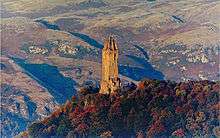Wallace Monument
The National Wallace Monument (generally known as the Wallace Monument) is a tower standing on the shoulder of the Abbey Craig, a hilltop overlooking Stirling in Scotland.[1] It commemorates Sir William Wallace, a 13th-century Scottish hero.[2]


Background
The tower was constructed following a fundraising campaign, which accompanied a resurgence of Scottish national identity in the 19th century. In addition to public subscription, it was partially funded by contributions from a number of foreign donors, including Italian national leader Giuseppe Garibaldi. The foundation stone was laid in 1861 by the Duke of Atholl in his role as Grand Master Mason of Scotland with a short speech given by Sir Archibald Alison.[3]
It was completed in 1869 to the designs of architect John Thomas Rochead at a cost of £18,000,[4] the monument is a 67-metre (220 ft) sandstone tower, built in the Victorian Gothic style.
The tower stands on the Abbey Craig, a volcanic crag above Cambuskenneth Abbey, from which Wallace was said to have watched the gathering of the army of King Edward I of England, just before the Battle of Stirling Bridge in 1297. The monument is open to the general public. Visitors climb the 246 step spiral staircase to the viewing gallery inside the monument's crown, which provides expansive views of the Ochil Hills and the Forth Valley.
A number of artifacts believed to have belonged to Wallace are on display inside the monument, including the Wallace Sword, a 1.63-metre (5 ft, 4 in) long sword weighing almost three kilograms.[5] Inside is also a Hall of Heroes, a series of busts of famous Scots, effectively a small national Hall of Fame. The heroes[6] are Robert the Bruce, George Buchanan, John Knox, Allan Ramsay, Robert Burns,[7] Robert Tannahill, Adam Smith, James Watt, Sir Walter Scott, William Murdoch, Sir David Brewster, Thomas Carlyle,[8] Hugh Miller, Thomas Chalmers, David Livingstone, and W. E. Gladstone.[9] In 2017 it was announced that Mary Slessor and Maggie Keswick Jencks will be the first heroines to be celebrated in the hall.[10]
Statue of Wallace
The original Victorian statue of Wallace stands on the corner of the monument and is by the Edinburgh sculptor David Watson Stevenson.[11]
Braveheart statue
In 1996 Tom Church carved a statue of Wallace called "Freedom", which was inspired by the film Braveheart.[12] It has the face of Mel Gibson, the actor who played William Wallace in the film. Church leased the statue to Stirling Council, who in 1997 installed it in the car park of the visitor centre at the foot of the craig.[12] The statue was deeply unpopular, being described as "among the most loathed pieces of public art in Scotland" [13] and was regularly vandalised [14] before being placed in a cage to prevent further damage. Plans to expand the visitor centre, including a new restaurant and reception, led to the unpopular statue's removal in 2008.[15] It was returned to Church, who, after an unsuccessful attempt to sell it at auction,[13] reportedly offered it to Donald Trump's Menie estate golf resort.[16] However, it remained in the garden of the sculptor's home, where it was incorporated into a replica of a castle, and with additions to it that included the head of the decapitated governor of York.[17] In April 2016, it was reported in local press that the statue might be moved to Ardrossan's old Barony Church.[18]
See also
- William Wallace Statue, Aberdeen
- Wallace's Monument, Ayrshire
- William Wallace Statue, Bemersyde
- Wallace's Monument, Elderslie
References
- Illustrated guide to Stirling and the national Wallace monument (9th ed.). Stirling: Mackay, Eneas. 1897. pp. 1–16. Retrieved 7 October 2017.
- "Wallace Monument - Stirling Tourist Attraction - Home".
- Logie: A Parish History, Menzies Fergusson, 1905
- "DSA Building/Design Report: Wallace Monument". Dictionary of Scottish Architects. Retrieved 3 January 2009.
- "Scottish Wars of Independence". BBC Scotland. Retrieved 4 September 2013.
- Shearer's Stirling : historical and descriptive, with extracts from Burgh records and Exchequer Roll volumes, 1264 to 1529, view of Stirling in 1620, and an old plan of Stirling. Stirling: R.S. Shearer & Son. 1897. p. 114. Retrieved 24 June 2017.
- Harvey, William (1899). Robert Burns in Stirlingshire. Stirling: E. Mackay. Retrieved 24 June 2017.
- Masson, David (1891). Carlyle : the address delivered by David Masson on unveiling a bust of Thomas Carlyle in the Wallace Monument. Glasgow. Retrieved 24 June 2017.
- "Hall of Heroes". National Wallace Monument. Retrieved 24 June 2017.
- "Scotland's Heroines – marking their place in history". National Wallace Monument. Retrieved 24 June 2017.
- "David Watson Stevenson RSA - Mapping the Practice and Profession of Sculpture in Britain and Ireland 1851-1951".
- Kevin Hurley (19 September 2004). "They may take our lives but they won't take Freedom". Scotland on Sunday. Retrieved 16 October 2009.
- "They may take our lives but they won't take Freedom".
- "Wallace statue defaced". The Herald. 17 August 1998. Retrieved 18 September 2014.
- "Wallace statue back with sculptor". BBC News. 16 October 2009. Retrieved 16 October 2009.
- Administrator, dailyrecord (23 April 2008). "Donald Trump to be given controversial William Wallace statue".
- Bayer, Kurt (24 October 2009). "Sculptor's anger as thieves nick his Braveheart statue".
- "Wallace statue and memorabilia to get new home in old Barony Church". Ardrossan & Saltcoats Herald. 12 April 2016.